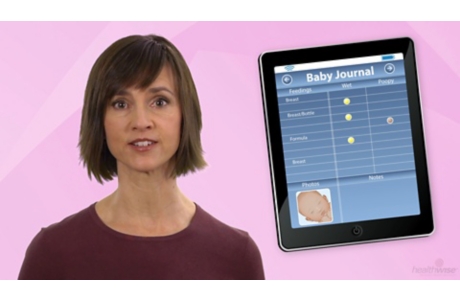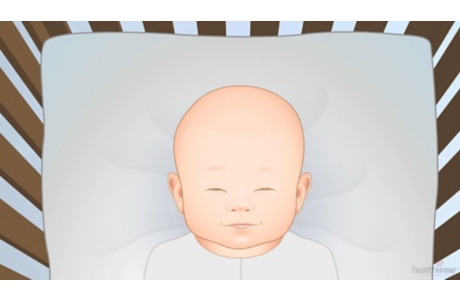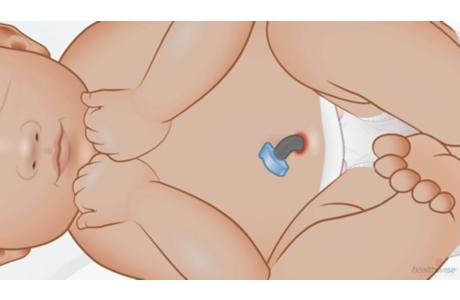Mastitis While Breastfeeding
Condition Basics
What is mastitis?
Mastitis is a breast inflammation usually caused by infection. It can happen to any woman. But it's most common during the first 6 months of breastfeeding, especially during the baby's first 2 months. After 2 months, the baby's feeding patterns become more regular, which helps prevent mastitis.
Mastitis can leave a new mother feeling very tired and run-down. Add the illness to the demands of taking care of a newborn, and many women quit breastfeeding altogether. But you can keep nursing your baby. In fact, breastfeeding usually helps to clear up infection. Nursing won't harm your baby.
Mastitis can be discouraging and painful. But it is usually easily cleared up with medicine.
What causes it?
Mastitis most often happens when bacteria enter the breast through the nipple. This can happen when a nursing mother has a cracked or sore nipple. Going for a long time between nursing sessions or not emptying the breast completely may also make mastitis more likely.
What are the symptoms?
If you have mastitis, you may first notice:
- A painful area on one breast. It may be red, warm to the touch, or both.
- Chills, aches, and flu-like symptoms.
- A fever.
These first symptoms may start after you have reopened a blocked milk duct.
Signs that mastitis is getting worse include swollen and painful lymph nodes in the armpit next to the infected breast, a fast heart rate, and flu-like symptoms that get worse. Mastitis can lead to a breast abscess, which feels like a hard, painful lump.
The symptoms of mastitis most often appear within 4 to 6 weeks after childbirth.
How is it diagnosed?
Your doctor can usually diagnose mastitis based on your symptoms and by checking your affected breast. Tests usually aren't needed.
How is mastitis treated?
Treatment for mastitis includes taking antibiotics and regularly emptying your breast by breastfeeding or pumping your breast milk. Self-care includes taking acetaminophen (such as Tylenol) and using hot or cold compresses to ease your discomfort. Treating mastitis right away helps keep the infection from getting worse and usually eases symptoms.
Prevention
Nursing moms sometimes get mastitis when bacteria enter the breast through a cracked or sore nipple. Taking these steps can help prevent mastitis.
- Breastfeed regularly.
Routine breastfeeding prevents bacteria from building up. If you know you'll go more than 4 hours without feeding your baby, arrange to pump.
- Drink plenty of fluids.
If you drink something while you breastfeed, it can help you stay hydrated.
- Position yourself well.
When you and your baby are aligned, the baby can latch on to the areola, not just the nipple.
- Use different positions.
This can help drain all areas of your breast. Try breastfeeding positions such as the Australian hold, the cradle hold, the cross-cradle hold, the football hold, and the side-lying position.
- Alternate which breast you offer first.
- Wear a bra that isn't too tight or restrictive.
- Take care of your nipples.
- Air-dry your nipples after you breastfeed. This can prevent irritation and cracking.
- Use an over-the-counter lanolin-based cream on your nipples, such as Lansinoh.
- Get help from your doctor or a lactation consultant for sore or cracked nipples.
- Wean your baby gradually.
Gradual weaning helps prevent your breasts from getting too full.
Learn more
Watch
Symptoms
If you have mastitis, you may first notice:
- A painful area on one breast. It may be red, warm to the touch, or both.
- Chills, aches, and flu-like symptoms.
- A fever.
These first symptoms may start after you have reopened a blocked milk duct.
Signs that mastitis is getting worse include swollen and painful lymph nodes in the armpit next to the infected breast, a fast heart rate, and flu-like symptoms that get worse.
The symptoms of mastitis most often appear within 4 to 6 weeks after childbirth.
In some cases, symptoms of mastitis get worse and the breast forms a pocket of pus (abscess) in the infected area.
Thrush infection
Thrush (yeast infection) can occur in your baby's mouth and spread to your nipples and breast ducts. You may have a yeast infection if you have:
- Symptoms of mastitis that don't go away with treatment.
- Pain in the nipple area during and after you breastfeed.
- Sharp breast pain between feedings.
- Nipples that look very pink.
If you have yeast infection symptoms, both your nipples and your baby's mouth should be checked for thrush.
Thrush can also begin with a sudden start of pain or burning when breastfeeding has been going well without problems.
Symptoms of a breast abscess
Symptoms of a breast abscess include a breast lump that is hard and painful and a reddened area on the breast. You may also have flu-like symptoms that are getting worse.
Exams and Tests
Your doctor can usually diagnose mastitis based on your symptoms and by checking your affected breast. Tests usually aren't needed. But tests may be done to confirm a diagnosis. They may also be done to help guide treatment for other problems that can develop.
If you have an infection that isn't improving with treatment, your doctor may do a breast milk culture. To provide a sample for a culture, you will squeeze a small sample of milk from the affected breast onto a sterile swab. The culture results help your doctor confirm a diagnosis and find out the specific bacteria causing the infection.
Culture results may also be used to find out which antibiotic will work best for you.
Diagnosing a breast abscess
Your doctor can diagnose a breast abscess by checking your breast. If an abscess is too deep to check by touching it, your doctor may use a breast ultrasound. Ultrasound can also guide a needle to drain the abscess. A culture can then be done to identify the bacteria that are causing the abscess.
Learn more
Treatment Overview
Mastitis won't go away without treatment. Treating it right away helps keep the infection from quickly getting worse and usually eases symptoms after about 2 days. Delaying treatment can lead to an abscess, which can be harder to treat.
Treatment usually includes:
- Taking antibiotics. They destroy the bacteria causing the infection.
- Regularly emptying your breast by breastfeeding or pumping breast milk. This helps prevent more bacteria from collecting in the breast. It may shorten the time that the infection lasts.
- Self-care. This includes varying your breastfeeding positions and taking acetaminophen to relieve pain, fever, or discomfort. You can rest as needed and use an ice pack or warm compress on your breast.
You can safely keep breastfeeding your baby or pumping breast milk to feed your baby during illness and treatment. Your breast milk is safe for your baby to drink. Any bacteria in your milk will be destroyed by the baby's digestive juices.
Treating a breast abscess
Treatment for a breast abscess includes:
- Draining the abscess. Healing can take 5 to 7 days.
- Antibiotics that you take by mouth. They destroy the bacteria that are causing the infection. Antibiotics are given through a vein (intravenously) only in rare cases of severe infection.
- Emptying the breast regularly and completely by breastfeeding or pumping. This is also very important for keeping a good milk supply.
Most women can keep breastfeeding with the affected breast while an abscess heals. With your doctor's approval, you can cover the abscess area with a light gauze dressing while you breastfeed.
If you are told to stop breastfeeding from the affected breast while an abscess heals, you can keep breastfeeding from the healthy breast. Be sure to pump or express milk from the infected breast regularly.
Learn more
Self-Care
Taking antibiotics and continuing to breastfeed or pump will help clear up mastitis. You can also take these steps to feel better.
- Take an over-the-counter medicine.
- Acetaminophen (such as Tylenol) can help with pain, fever, or discomfort.
- You can also take ibuprofen (such as Advil) along with acetaminophen to reduce inflammation.
- Rest as much as you can.
- Use an ice pack or warm compress.
Cold and heat can reduce pain in the sore breast.
- If you use an ice pack, place it on the outside of your bra or clothes.
- Do not put the ice on your bare skin.
- Drink extra fluids.
- Pump a little first if your breasts are very full (engorged).
A breast that isn't quite so full can be easier for your baby to latch on to.
- Wash off pus.
If pus drains from your nipple, gently wash it off. Let your nipple air dry before you put your bra back on. You can also use a disposable breast pad to absorb the pus.
If you have trouble breastfeeding, you can get more help and support from your doctor or a lactation consultant.
Breastfeeding when you have mastitis
Antibiotics are used to treat mastitis. But breastfeeding is also a great way to prevent bacteria from collecting in the breast. It can also shorten the time that the infection lasts.
- Breastfeed often.
Your baby is the most efficient way to empty your breasts. And your milk is safe for your baby to drink. Your baby's digestive juices will destroy any bacteria in your milk.
- Try to start on the sore side.
- If you need to start on the other side, be sure to switch and empty the affected breast completely—until it is soft.
- Vary your breastfeeding positions to be sure to empty your breasts.
- If it's too painful to breastfeed at all, you can pump or express your milk.
- Use a warm, wet washcloth on your sore breast.
The heat from the washcloth can help increase milk flow.
- Place the washcloth on the affected breast 15 minutes before you start to breastfeed.
- Try this at least 3 times a day.
- Massage the sore breast.
This can also increase milk flow.
- Use creams for sore or cracked nipples.
Try a lanolin-based cream, such as Lansinoh.
- Replace nursing pads often.
Dry and clean pads are best.
Learn more
Watch
Credits
Current as of: November 27, 2023
Author: Healthwise Staff
Clinical Review Board
All Healthwise education is reviewed by a team that includes physicians, nurses, advanced practitioners, registered dieticians, and other healthcare professionals.
Current as of: November 27, 2023
Author: Healthwise Staff
Clinical Review Board
All Healthwise education is reviewed by a team that includes physicians, nurses, advanced practitioners, registered dieticians, and other healthcare professionals.
















